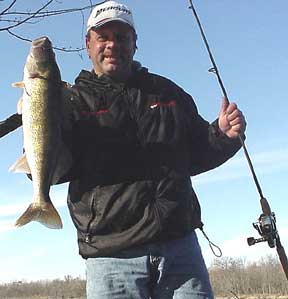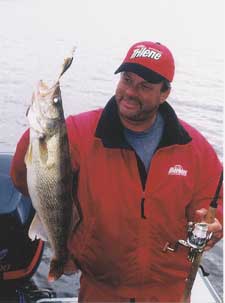 Trophy walleyes are a lot like celebrities.
Trophy walleyes are a lot like celebrities.
You read a lot about their glamorous lives, but you seldom get to know them. You see them on the covers of magazines and featured in television specials, but then it’s hard to separate the fantasy from the reality.
Celebrities don’t shop for groceries at the local Piggly Wiggly. They send someone else to do it. They don’t buy their clothes at local department stores, and they don’t work out at the city rec center.
When they do venture out into public, they go to great lengths to stay out of the public eye. A chauffeur delivers them to the theater where they dash inside, or they pull up to the side entrance of a posh restaurant where a host whisks them into a private dining room.
Are big walleyes really so different? They, too, go to great lengths to avoid the public eye. They don’t frequent areas that are heavily congested. They become nocturnal for most of the year. They spend the majority of their lives in deep-water hangouts or roaming vast expanses of open water.
The trick for those of us who desire to get up close and personal with a big, beautiful walleye is to meet them on their own terms. For many of us, the best opportunity to make that happen is during the month of April where the need to procreate will lead the biggest walleyes into predictable locations with their preferred spawning habitat.
In general, that means wind-blown points, shallow humps, rock reefs or feeder streams in our natural lakes and reservoir systems. In our rivers, it means gravel, shale or rubble substrate in areas where current is present to help incubate the eggs and distribute the hatching fry.
Anglers know all this. Visit almost any notable body of walleye water this time of year and there will be large groups congregated in specific areas, usually slipping the current and bouncing leadhead jigs or trolling crankbaits on lead-core line along current breaks and dropoffs.
Those approaches take their share of big walleyes that slide into the depths during daylight hours and ignore most of what goes on around them, save for those brief moments each day when something catches their eye or they feel the urge to feed.
 But, you have to enjoy playing bumper boats and winding through traffic like a race car on pit road to stay on the fish.
But, you have to enjoy playing bumper boats and winding through traffic like a race car on pit road to stay on the fish.
While many anglers are hovering over those areas like fat cats waiting to pounce on vulnerable prey, there is another much smaller group that truly has the skinny on big spring walleyes.
They are the ones who go where few other anglers venture. They are the loners present on every body of water who causes others to ask, ‘What’s that fool think he’s doing there?'”
Chances are, he or she is in the shallows and on a big walleye pattern that isn’t always easy to fish, but can be extraordinarily rewarding.
It makes sense, both biologically and sociably.
Celebrities get paid to look good. They never know when a television or still camera will be present, and the sooner they can get rid of that unshapely belly full of eggs, the better. In theory at least, by warming their bodies in shallow water, they can accelerate the spawning process.
Spring typically means stained or slightly muddy water, especially in river systems where snow melt and April showers are factors. Sediment particles retain and transfer warmth, helping the shallows warm quickly. Walleyes are comfortable there and more likely to be active than they might be in clearer water.
And because shallow water does warm faster, especially when the sun gets high overhead at mid-day, it’s the first place the aquatic circle of life begins each spring. That means the presence of baitfish and all kinds of other creatures that provide a variety of menu items that require little effort to consume.
The shallows are also relatively quiet, at least when compared to the main channels in our river systems or the primary structure in lakes and reservoirs. Walleyes feel secure there away from the buzz of outboard engines and the steady parade of jigs and other baits.
 There are a couple of ways to effectively target these fish.
There are a couple of ways to effectively target these fish.
It’s been my experience that trolling presentations tend to be more productive because shallow-water walleyes tend to be scattered over flats or atop shelves protruding from shore. Cover more water and you will put your baits in front of more fish.
In my opinion, you can’t fish too shallow. I recall taking second place in a springtime Masters Walleye Circuit tournament years ago casting crankbaits into water only two or three feet deep as it ran over a sandbar.
My general rule of thumb is that if you can’t see bottom, the walleyes will be there. Even when many anglers talk about fishing shallow, they aren’t fishing shallow enough.
Start simple. Although you don’t see it done much any more, my dad introduced us to spring walleye fishing by simply casting a 3/8-ounce or 1/2-ounce jig out to the side of our old 14-foot boat and jerking it along while trolling upstream. We used to catch a lot of nice fish.
If you can’t get the jigs to produce, try long-lining crankbaits. I like to point my Triton 215X into the current and troll a zig-zag pattern because it changes the speed of my lures and keeps them swinging out to the side of the boat. Because the water is so shallow and walleyes are by nature a spooky critter, I’ll use my Optima-powered MinnKota 101 Maxum Pro bow mount or my MinnKota Engine Mount 101 to pull me upstream.
Where two rods are legal, I put one in my Tempress rod holder and keep the other in hand so I can sweep the bait forward occasionally. Sometimes, that will trigger far more strikes than a lure moving at a consistent clip.
Select crankbaits that will run in the top foot or two of the water column. Walleyes usually lay in the depressions and behind the humps of sand in the shallows and will come up to get a lure. Two of my favorites are the Original Floating Rapalas and shallow-running Shad Raps. Both can be deadly, depending on the mood of the fish. Go with the stickbait and slow down when the bite is slow. Use the Shad Rap and speed up when the fish seem more aggressive. Vary the length of line from the board to the lure until you find the depth where they run trouble-free.
Because the water is usually stained or at least dingy, I like bright colors such as chartreuses and oranges, and rattles are definitely a plus. If you feel the need to add more olfactory stimuli, try hooking a piece of crawler on the lure’s front hook.
Occasionally, there’s a need for ultra stealth. That’s where a couple of Off-Shore planer boards can guide your lures through the shallowest of water while keeping them well away from the boat. This presentation also allows you to keep your boat in slightly deeper water where stumps and rocks aren’t as much of a threat to the well-being of your boat, motors and props.
When the current is really moving on a river system, you may need to employ both a bow-mount and transom-mount trolling motor for the combination of power and control it provides. I’ve also used my Mercury 9.9 pro kicker in conjunction with the MinnKota bow-mount when pulling boards through the shallows.
No matter which trolling presentation you settle on, your choice of line is critical. You need something strong and abrasion-resistent to help you get through some of the brush and rock you will encounter, but you also need something with at least a little stretch because shallow-water walleyes are notorious for hitting hard and coming straight to the surface and there is a lot of margin for error when they are 100 feet behind the boat.
Yo-Zuri’s Hybrid line exactly fits my needs. It’s tough, but slightly forgiving. Coupled with sharp hooks, it gives me a fighting chance to land almost every big walleye I hook.
I always try a few downstream trolling passes, as well, when the current allows. You have to move faster than the current to keep crankbaits working effectively, and that can mean 3 1/2-4 mph. It’s a presentation that forces reaction strikes from fish that otherwise won’t commit to a crank.
Want to be a star in your angling circle this April? Get skinny.










